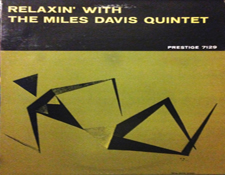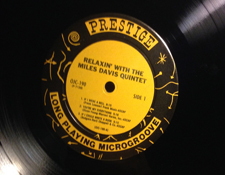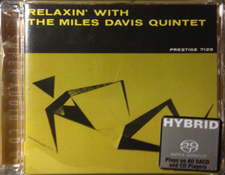It’s the time of year for saving money!
I recently had the good fortunate to happen upon a garage sale where the owner was selling off a large portion of his record collection for very fair prices, given what he had. Living in a big city like San Francisco, it’s not an uncommon occurrence to find people selling records ‘n stuff on a street corner. However, this fellow had a lot of really uncommon albums for sale, things you don’t normally see at garage sales. So for $3 each, I walked away with 10 pristine jazz albums. Most were still in the original shrink wrap and appeared to have barely been played, if at all. These were all pressings from the mid-to-late 1980s on Prestige Records (then owned by the Fantasy Records label), part of their “Original Jazz Classics” reissue series by artists including John Coltrane, Sonny Rollins, Cannonball Adderly, Eric Dolphy, Wes Montgomery and Miles Davis.
 When I got home I was pleased to find that most were albums I did not already own in other formats. There were only two which I happened to have on real nice SACD reissues, and that discovery spurred the idea for this article (and, perhaps, a series of articles to come).
When I got home I was pleased to find that most were albums I did not already own in other formats. There were only two which I happened to have on real nice SACD reissues, and that discovery spurred the idea for this article (and, perhaps, a series of articles to come).
One of the SACDs I had was Miles Davis’ classic 1956 session called Relaxin‘, which features one of his finest quintets including John Coltrane on tenor saxophone, Red Garland on piano, Paul Chambers on bass and Philly Joe Jones on drums.
This is a fine, fine recording and performance, so I’m not even going to go near any sort of analysis of the music held within as I’m sure you can find many others discussing that on our beloved Interwebs. If you don’t have this (and others from the same sessions) you really should seek out this music in some format of your choice. (Here are links to the album and the SACD.)
I will say that as a music enthusiast and record collector, reissues hold a very important position in the music food chain because of the difficulty of finding a pristine original “deep groove” type pressing from the 1950s. You do see them, but often they are very expensive, sometimes running into the hundreds of dollars range depending on the album’s scarcity and the artist’s popularity. And even then, they are rarely truly pristine in an audiophile sense for many reasons (vinyl quality, how the disc was cared for, usage, etc.)
This is especially significant for those of you audiophiles who have little tolerance for a pop or tick or a visual-but-not-audible scuff mark on the disc. Those original pressings can cost some serious coin if you shop online or through any number of collector-oriented shops around the world.
Alternately, you can find things cheaper but that process requires a lot of patience and dedication. If you are like me, and like “the hunt” aspect of record collecting and don’t mind “crate digging” through untold number of garage sales, flea markets and dusty old antique and thrift shops, that is is one way you might find an original pressing at a cheap price.
But record hunters like me are a select and limited breed — it is a process that is certainly not for the impatient — so gaining easy access to a nicely prepared reissue is a good thing for the rest of us who want to hear the music as faithfully as possible while retaining some of that essence that made it special in the ’50s.
That latter point about “essence” is something I’ll get back to in a bit, but keep that in the back of your head as we proceed.
Now, I’ll be 1,000-percent up front here: My little so-called “shootout” here is not hard science. It is subjective, imperfect and largely based on my gut instincts and ears. So if you don’t like that sort of thing, then I would suggest you stop reading right here.
This is more of a review for the everyman (as most of my reviews are, actually). That said, I do pride myself on having good-quality gear, but stuff that is not out of reach to the average listener. Is it audiophile? That depends on your perspective. I do know that I have sat down a number of friends with much higher-end systems than mine, people with good listening “ears” and blown them away on my modest systems with everything from a mono promo single by the Chordettes (Mr. Sandman!) to a 5.0 surround mix on DVD Audio (David Crosby’s first album).
 Thus, I did this shootout on two different, very modest stereo systems I own and have set up (both with the same type of speakers: JBL 4410A studio monitors) and on two different turntables, both benefitting from tube phono preamplification courtesy of Bellari. The A/V receivers I have are by Denon and Pioneer. The turntables include a Music Hall MMF 7.1 with a Goldring 2400 cartridge and a late ’70s Kenwood (belt drive, with the hefty vibration isolating concrete resin base) fitted with a Sumiko Pearl cartridge. My SACD playback was done on my trusty old Oppo BD-83 multi-format player and an inexpensive Sony Blu-ray player (which of course is SACD-friendly).
Thus, I did this shootout on two different, very modest stereo systems I own and have set up (both with the same type of speakers: JBL 4410A studio monitors) and on two different turntables, both benefitting from tube phono preamplification courtesy of Bellari. The A/V receivers I have are by Denon and Pioneer. The turntables include a Music Hall MMF 7.1 with a Goldring 2400 cartridge and a late ’70s Kenwood (belt drive, with the hefty vibration isolating concrete resin base) fitted with a Sumiko Pearl cartridge. My SACD playback was done on my trusty old Oppo BD-83 multi-format player and an inexpensive Sony Blu-ray player (which of course is SACD-friendly).
So getting back to the Miles Davis Relaxin’ discs, I’ll start here with a comment that will probably annoy some of you who want a definitive choice presented: Both are really good-sounding discs, each delivering very different listening experiences.
The SACD offers up a lovely high-resolution soundstage, the tape source used seemingly to be from an unfiltered (for lack of a better phrase) transfer off (one assumes) “the master.” Thus there is plenty of tape hiss apparent, which I view as a good thing, indicating that — perhaps — they didn’t try to de-hiss things using various and sundry processors and equalization. I will suggest that the audible hiss might be a result of the tape being presented in an uncompressed manner for the SACD — for LP mastering, the engineers might have had to reign certain dynamics in a bit. This is a guess…
That said, the SACD version is a different listen than the LP, not harsh as a standard CD might be, but still a little on the angular side. This is most apparent when players like Miles Davis and John Coltrane attack their notes at the beginning of certain phrases. Instead of a warm hit to the senses, you get a sharp tang in your ear.
Of course this raises the question: Is that attributable to the SACD format or simply a matter of us hearing what is actually on the recording?
I don’t know.
This does drive me to wonder if perhaps the original session producer, Rudy Van Gelder, might have been recording his stuff a little hot knowing that things would get pulled back quite a bit for actual LP mastering. Thus — on the SACD — when Miles attacks a note on his trumpet or Coltrane on his tenor sax, you get a great sense of “bite” coming through the speakers whereas on the LP that sensation is tempered somehow.
]]>If you have ever performed in an orchestra or band and have played alongside either of these instruments (I studied trumpet for 8 years and played through high school) you know that there can well be some … let’s call it “tartness” to the initial notes, especially if the artist is in the moment and reaching for the stars of improvisation.
 That said, when you hear the same music on the LP reissue version of Relaxin’, that bite is tempered yet not diminished. The hiss is reined in a great deal. That is not to say that the high end is compromised. To the contrary, the LP sounds really crisp and tremendous, complemented by a round midrange and sumptuous low end.
That said, when you hear the same music on the LP reissue version of Relaxin’, that bite is tempered yet not diminished. The hiss is reined in a great deal. That is not to say that the high end is compromised. To the contrary, the LP sounds really crisp and tremendous, complemented by a round midrange and sumptuous low end.
And therein lies the rub in trying to do a shootout like this: Are we comparing oranges and apples here?
This process also does make me curious to learn more about Mr. Van Gelder’s techniques — and perhaps I need to do some more research at some point to see if any books have been written about him. I would like to know if his recordings were optimized for listening via a long playing 33-1/3 RPM vinyl album (as opposed to hearing the tape in uncompressed form on the SACD).
Again, both versions sound real good, yet my ear leans toward the vinyl with regards to overall listening pleasure — I like the warmth afforded by the vinyl playback process, including the effect of tube pre-amplification before heading to my amplifiers.
If the Wikipedia entry has any validity, my curiosity about Van Gelder’s approach has long been thus stuff of industry speculation:
“Van Gelder was secretive about his recording methods, leading to much speculation among fans and critics about particular details. His recording techniques are often admired for their warmth and presence.”
Indeed, in a 2012 interview for blog Jazzwax.com, Van Gelder is quote as having said: “I always wanted to be in control of the entire recording chain — from the initial recording through mastering. Why not? It had my name on it.”
So with this little review-of-sorts I have neither made a definitive conclusion on which version is better, nor can even offer you, Dear Readers, a conclusive pointer as to which path to take. Ultimately, it is the performances that matter so getting the music in some form is the crucial thing. Then, your ability to get TO the music is the second most important thing.
If your preferred playback vehicle is the LP, I don’t think you will be disappointed by the reissues and certainly an original pressing if you can find one. If you like SACDs, the 2004 reissue of Relaxin’ by the Miles Davis Quintet sounds equally fantastic, albeit a little different with a brighter high end and more noticeable amounts of tape hiss.
Hopefully this will give you some ability to make a fairly knowledgeable leap to make the album purchase one way or another. Either way, Relaxin’ is a great recording and performance, one you should have in your collection.






